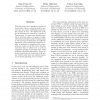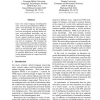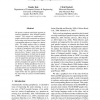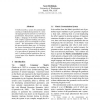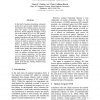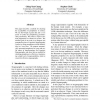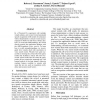NAACL
2010
13 years 9 months ago
2010
With the recent rise in popularity and size of social media, there is a growing need for systems that can extract useful information from this amount of data. We address the probl...
NAACL
2010
13 years 9 months ago
2010
Like most natural language disambiguation tasks, word sense disambiguation (WSD) requires world knowledge for accurate predictions. Several proxies for this knowledge have been in...
NAACL
2010
13 years 9 months ago
2010
We present a random-walk-based approach to learning paraphrases from bilingual parallel corpora. The corpora are represented as a graph in which a node corresponds to a phrase, an...
NAACL
2010
13 years 9 months ago
2010
For millions of people in less resourced regions of the world, text messages (SMS) provide the only regular contact with their doctor. Classifying messages by medical labels suppo...
NAACL
2010
13 years 9 months ago
2010
I briefly describe a system for automatically creating an implemented grammar of a natural language based on answers to a web-based questionnaire, then present a grammar of Sahapt...
NAACL
2010
13 years 9 months ago
2010
In the field of machine translation, automatic metrics have proven quite valuable in system development for tracking progress and measuring the impact of incremental changes. Howe...
NAACL
2010
13 years 9 months ago
2010
Adaptor grammars extend probabilistic context-free grammars to define prior distributions over trees with "rich get richer" dynamics. Inference for adaptor grammars seek...
NAACL
2010
13 years 9 months ago
2010
This paper describes a method for checking the acceptability of paraphrases in context. We use the Google n-gram data and a CCG parser to certify the paraphrasing grammaticality a...
NAACL
2010
13 years 9 months ago
2010
In a Wizard-of-Oz experiment with multiple wizard subjects, each wizard viewed automated speech recognition (ASR) results for utterances whose interpretation is critical to task s...
NAACL
2010
13 years 9 months ago
2010
This paper introduces the novel task of topic coherence evaluation, whereby a set of words, as generated by a topic model, is rated for coherence or interpretability. We apply a r...
